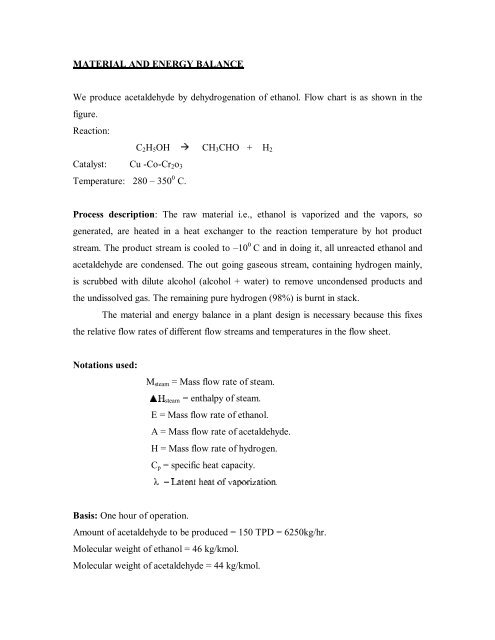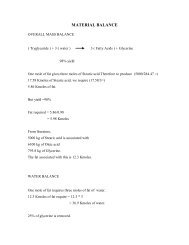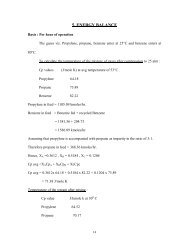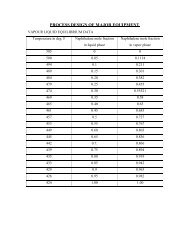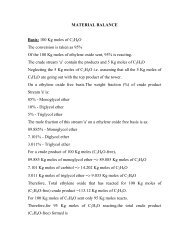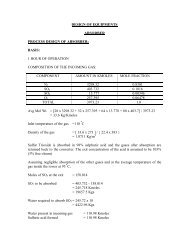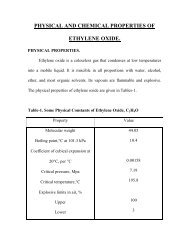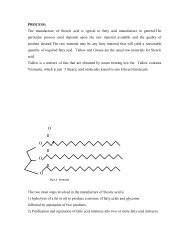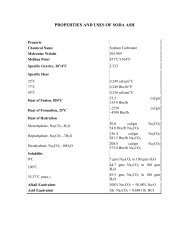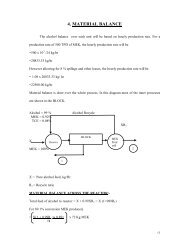MATERIAL AND ENERGY BALANCE We produce acetaldehyde by ...
MATERIAL AND ENERGY BALANCE We produce acetaldehyde by ...
MATERIAL AND ENERGY BALANCE We produce acetaldehyde by ...
- No tags were found...
You also want an ePaper? Increase the reach of your titles
YUMPU automatically turns print PDFs into web optimized ePapers that Google loves.
<strong>MATERIAL</strong> <strong>AND</strong> <strong>ENERGY</strong> <strong>BALANCE</strong><strong>We</strong> <strong>produce</strong> <strong>acetaldehyde</strong> <strong>by</strong> dehydrogenation of ethanol. Flow chart is as shown in thefigure.Reaction:C 2 H 5 OH Æ CH 3 CHO + H 2Catalyst: Cu -Co-Cr 2 o 3Temperature: 280 – 350 0 C.Process description: The raw material i.e., ethanol is vaporized and the vapors, sogenerated, are heated in a heat exchanger to the reaction temperature <strong>by</strong> hot productstream. The product stream is cooled to –10 0 C and in doing it, all unreacted ethanol and<strong>acetaldehyde</strong> are condensed. The out going gaseous stream, containing hydrogen mainly,is scrubbed with dilute alcohol (alcohol + water) to remove uncondensed products andthe undissolved gas. The remaining pure hydrogen (98%) is burnt in stack.The material and energy balance in a plant design is necessary because this fixesthe relative flow rates of different flow streams and temperatures in the flow sheet.Notations used:M steam = Mass flow rate of steam.x+ steam = enthalpy of steam.E = Mass flow rate of ethanol.A = Mass flow rate of <strong>acetaldehyde</strong>.H = Mass flow rate of hydrogen.C p = specific heat capacity. /DWHQW KHDW RI YDSRUL]DWLRQBasis: One hour of operation.Amount of <strong>acetaldehyde</strong> to be <strong>produce</strong>d = 150 TPD = 6250kg/hr.Molecular weight of ethanol = 46 kg/kmol.Molecular weight of <strong>acetaldehyde</strong> = 44 kg/kmol.
Molecular weight of hydrogen = 2 kg/kmol.Therefore, amount of <strong>acetaldehyde</strong> to be <strong>produce</strong>d = 142.04 kmol/hr.Let conversion be 94%.Taking into account the losses let, the <strong>acetaldehyde</strong> <strong>produce</strong>d to be some extra.Let <strong>acetaldehyde</strong> to be <strong>produce</strong>d = 6500 kg/hr.Amount of ethanol required for 100% conversion = 6795.45 kg/hr.Therefore, ethanol required for 94% conversion = 7229.2 kg/hr.Vaporizer:100 0 C, super heated stream of ethanolSteam(Heating fluid)Condensed steam30 0 C, ethanolAs shown in the figure,Ethanol liquid inlet temperature = T i =30 0 C.Ethanol leaves as superheated steam at 100 0 C = T oHeating fluid is assumed to be saturated steam here and to provide sufficient temperaturegradient; it is taken to be about 3 atmospheric pressure. At this pressure it condenses at133.89 0 C and because process streams are normally available at this pressure.Condensing temperature of ethanol = 133.89 0 C.From steam table enthalpy of steam at this temperature = x+ steam = 514.9 kcal/kg.Boiling point of ethanol = T b = 78.4 0 C.Specific heat of ethanol, at 30 0 C = Cpi = 0.5976 kcal/kg 0 C.at 100 0 C = C po = 0.4382 kcal/kg 0 C./DWHQW KHDW RI YDSRUL]DWLRQ RI HWKDQRO ethanol = 200.6 kcal/kg.
From heat balance we have,M steam * x+ steam + E * C pi * (T i – T b (ethanol + E * C po * (T o – T b )Therefore, M steam = E * [ C pi * (T b – T i ethanol + C po * (T o – T b )] /x+ steam.M steam = 7229.2 * [0.5976 * (78.4 – 30) + 200.6 + 0.4382 * (100 – 78.4)] / 514.9= 3355.40 kg.Reactor:200 0 C, ethanolThe reaction in the reactor:310 0 C, A = 6500 kg.E = 295.45 kg.C 2 H 5 OH Æ CH 3 CHO + H 2Optimum reaction temperature = 310 0 C.Conversion = 94%.From material balance we have,Amount of <strong>acetaldehyde</strong> <strong>produce</strong>d = .94 * 44* 7229.2 / 46 = 6500 kg.Amount of hydrogen <strong>produce</strong>d = .94 * 2* 7229.2 / 46 = 295.45 kg.Amount of ethanol unreacted = 7229.2 – (6500 + 295.45) = 433.74 kg.If it is decided to use saturated steam at 133 atm. (steam at this pressure condenses at335.5 0 C), it means that the reactor should be a pressure vessel. This proposition isrejected because of high costs and it is decided to use saturated vapors of dowtherm,condensing at 350 0 C, for heating purposes.dowtherm = 56.5 kcal / kg.Heat of reaction = x+ r = 332.64 kcal / kg.
Assuming ethanol vapors enter the reactor at 200 0 C.From heat balance we can found amount of dowtherm required = M d .Specific heat capacity of ethanol = 0.539 kcal / kg 0 C.M d dowtherm = E * C p * (310 – 200) + E * x+ r * 0.94Therefore, M d = 7229.2 * [0.539 * (310 – 200) + 332.64 * 0.94] / 56.5= 47.594 * 10 3 kg.Heat exchanger:100 0 C, ethanolT 310 0 C.A= 6500 kg.H = 295.45 kg.200 0 C E = 433.75 kg.This is used only for heat recovery. Since it is assumed vapor is heated up to 200 0 C <strong>by</strong>the product stream of the reactor at 300 0 C.Let outlet temperature = T 0 C.C p of ethanol at 310 0 C = 0.549 kcal / kg 0 C.C p of <strong>acetaldehyde</strong> at 310 0 C = 0.528 kcal / kg 0 C.C p of hydrogen at 310 0 C = 2.485 kcal / kg 0 C.From heat balance we can find the outlet temperature.E*C p, ethanol *(200 – 100) = E*C p,ethanol *(310 – T) + H*C p,hydrogen *(310 –T ) + A*C p,acet7229.2*0.471*(200-100) = 433.75*0.549*(310-T) + 295.45*2.485*(310-T)+6500*0.528Therefore, T = 232.69 0 C.Condenser C 1 :
In condenser 1 it is decided to use cooling water at 300 0 C. the outlet temperatureof cooling water is not allowed to go above 50 0 C, because above this temperature, thereis a problem of vaporization. Normally the approach temp difference is about 10 0 C. Sincethe product can at best be cooled to 40 0 C, at this temperature the product stream would bea two-phase mixture and the mixture composition can be found out from VLE data.<strong>We</strong> make an approximate that; the information given at 699 mmHg is taken.At 400 0 C, ethanol in vapor phase = 4.1 mol%.Ethanol in liquid phase = 55 mol%.Let, m l = moles of liquid consisting of ethanol and <strong>acetaldehyde</strong>.m v = moles of vapor consisting of ethanol and <strong>acetaldehyde</strong>.Therefore from mole balance we have,0.55 * m l + 0.041 * m v = 9.430.45 * m l + 0.959 * m v = 147.42On solving above two equations we get, m l = 5.868 kmol.m v = 151.283 kmol.Vapor phase composition,Acetaldehyde = 145.08 kmol = 6383.52 kg.Ethanol = 6.2026 kmol = 285.32 kg.Liquid phase composition,Acetaldehyde = 2.6406 kmol = 116.186 kg.Ethanol = 3.2274 kmol = 148.460 kgCooling water at 30 0 C.T = 232.69 0 C Vapors at 40 0 C.H = 295.45 kg.H = 295.45 kg.E =433.75 kg. E = 433.75 kg ,A = 6500 kg.A =295.45 kgHeat balance,T = 50 0 CLiquid at 40 0 C, E = 148.46 kg.A = 116.186kg.
At 232.69 0 C,C p, hydrogen = 2.485 kcal / kg 0 C.C p, <strong>acetaldehyde</strong> = 0.417 kcal / kg 0 C.C p, ethanol = 0.5415 kcal / kg 0 C. <strong>acetaldehyde</strong> = 139.5 kcal / kg. ethanol = 200.6 kcal / kg.Heat given out <strong>by</strong> hydrogen = 295.45 * 2.485 * (232.69 – 40) = 141.47 * 10 3 kcal.Heat given out <strong>by</strong> <strong>acetaldehyde</strong> = 6500* 0.417 * (232.69 – 40) + 116.186 * 139.5= 538.5 * 10 3 kcal.Heat given out <strong>by</strong> ethanol = 433.75* 0.5415 * (232.69 – 40) + 148.46 * 200.6= 75.04 * 10 3 kcal.Total heat given out = 755.01 * 10 3 kcal.Let, M w = mass flow rate of cooling water.C p of water = 1 kcal / kg 0 C.Therefore, Mw = 755.01 * 10 3 / (1 * (50-30)).= 37.75 * 10 3 kg.Condenser 2:In condenser c 2 , it is desired to condense all ethanol and <strong>acetaldehyde</strong>. If theworking pressure is 1 atm. From the equilibrium data it is seen that for temperaturesbelow 30 0 C, there is going to be no ethanol in vapor phase and <strong>acetaldehyde</strong> would exertits vapor pressure at that temperature. If it is desired to achieve about 97% recovery of<strong>acetaldehyde</strong>, the outlet temperature of the product stream should be about –25 0 C.This isbecause at –22.6 0 C, its vapor pressure is 100 mmHg and the vapor phase will consists of13.15 mol%. In view of this, the cooling fluid chosen is saturated NH 3 at 1 atm. At whichit boils at –33.6 0 C.
Liquid ammonia at –33.86 0 C.Vapors at 40 0 C Vapors at –25 0E = 285.32 kg.H = 295.45 kg.A = 6383.52 kg.A = 191.5 kg.H = 295.45 kgSaturated ammonia vapor Liquid at 40 0 C.E = 285.32 kg.A = 6192.01 kg.Heat balance,At 40 0 C,C p, hydrogen = 3.399 kcal / kg 0 C.C p, <strong>acetaldehyde</strong> = 0.347 kcal / kg 0 C.C p, ethanol = 0.616 kcal / kg 0 C. <strong>acetaldehyde</strong> = 139.5 kcal / kg. ethanol = 200.6 kcal / kg. ammonia = 590 kcal / kg.Heat given out <strong>by</strong> hydrogen = 295.45 * 3.399 * (40 + 25) = 65.275 * 10 3 kcal.Heat given out <strong>by</strong> <strong>acetaldehyde</strong> = 6383.52* 0.347 * (40+ 25) + 6192.01 * 139.5= 1007.765 * 10 3 kcal.Heat given out <strong>by</strong> ethanol = 285.32* 0.616 * (40+25) + 285.32 * 200.6= 68.659 * 10 3 kcal.Total heat given out = 1141.699 * 10 3 kcal.Let M ammonia = mass flow rate of ammonia.Therefore, M ammonia = 1141.699 * 10 3 / 590.= 1935.083 kg.Preheater:
The preheater to the distillation column is necessary because the feed plate will becompletely chilled if the feed is not heated. The water stream from condenser c 1 isavailable at 50 0 C and is used in the preheater. If the maximum approach temperaturedifference is 10 0 C, the product stream can at best be heated to 40 0 C. the distillationcolumn pressure is chosen to be 1158 mmHg so that pure <strong>acetaldehyde</strong> is obtained asliquid product at 40 0 C. In view of this, the stream coming out of the preheater is liquid.Heat balance,At 40 0 C,C p, <strong>acetaldehyde</strong> = 0.347 kcal / kg 0 C.C p, ethanol = 0.616 kcal / kg 0 C.Let, M w = mass flow rate of cooling water.M w * (50-30) = 433.78 * (40 + 25)* 0.616 + 6308.196*(40+25)*0.347Therefore, M w = 7982.49 kg.Distillation column:In distillation column <strong>acetaldehyde</strong> condenses at 40 0 C. since vapor pressure data’sof pure gas is not available, it is estimated using Antoine’s equation.ln P = A + B/TWhere, A and B are constants, they can be determined from boiling point data at,Pressures 760 mmHg and 400 mmHg.At 760 mmHg T = 20.2 0 C= 293.2 0 K.400 mmHg T = 4.9 0 C = 277.9 0 K.Therefore, ln 760 = A + B/293.2ln 760 = A + B/277.9On solving above two equations we get,A = 18.29 and B = -3418.2Therefore, ln P = 18.29 – 3418.2/TTherefore at 40 0 C, P = 1586.41 mmHg.D = 6372.56 kg.
x d = 0.99E = 433.78 kg.A = 6308.196 kg.Total feed = F = 6741.976 kg.x f = 0.93W = 369.416 kg.x w = 0.06Assume 99% <strong>acetaldehyde</strong> recovery in overhead product.Assume x d = 0.99In overhead:Acetaldehyde = 6245.11 kg.Ethanol = 127.45 kg.Total D = 6372.56 kg.In bottom:Acetaldehyde = 63.082 kg.Ethanol = 306.334 kg.Total W = 369.416 kg.F = D + WF * x f = D * x d + W * x wTherefore, x w = F * x f – D * x dW * x wx w = 6741.976 * 0.93 – 6372.56 * 0.99 = 0.06369.416Assume reflux ratio = 0.3


